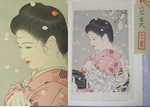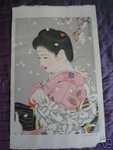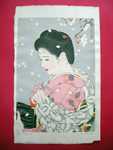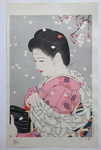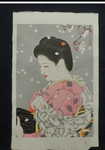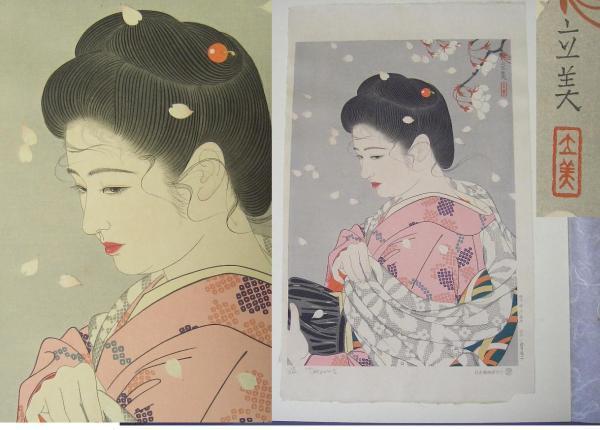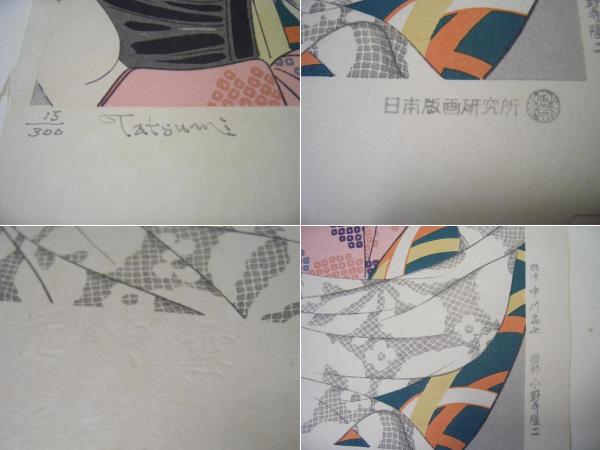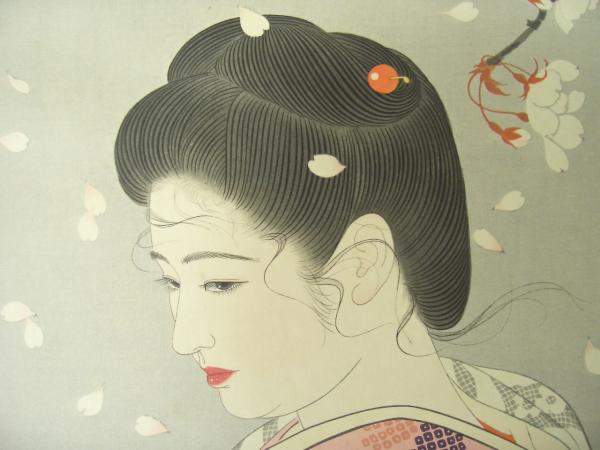| | |
| Artist: | Shimura Tatsumi (1907-1980) — 志村立美 |
| Title: | Falling Cherry Blossoms (Hanafubuki) — 花吹雪 |
| Series: | Gendai Bijin Fuzoku Gotai |
| Date of first edition?: | 1952 |
| Date of this artwork?: | 1960s/70s/80s (may not be accurate) |
| Publisher (first edition)?: | Nihon Hanga Kenkyusho |
| Publisher (this edition)?: | Nihon Hanga Kenkyusho |
| Medium (first edition): | Woodblock |
| Medium (this edition): | Woodblock |
| Format (first edition): | Large Oban
|
| Format (this edition): | Large Oban |
| DB artwork code: | 33076 |
| Notes (first edition)?: |
Dating of 1952, written on the original first-edition folders, has been confirmed by a collector.
In regards to the scene, "Late Summer", a collector in Finland as stated "My mother in law got it from a Japanese Olympic delegate in Helsinki 1952". As the most common dating of this series is *circa* 1953, I think it is now most likely that this series was first published in 1952.
See my article at Ohmi Gallery for details of this series and the various editions.
Title: Five Figures of the Modern Beauties - Falling Cherry Blossoms
Very early edition; Gendai Bijin Fuzoku Gotai
Artist Tatsumi Shimura 1907-1980
Signature "Tatsumi".
Seal Artist's red, rectangular seal.
Dated 1953.
Publisher Nihon Hanga Kenkyujo.
Medium/Technique Woodblock print.
Title is embossed on the bottom margin.
Description "Hanafubuki" ("Shower of Cherry Blossoms"). From the series "Gendai Bijin Fuzoku Gotai" ("Five Figures of the Modern Beauties"). A beauty is straitening her shawl in a windy spring day. The shower of the falling cherry petals are dancing around her.
Note Carver Yanoshita Tadashichi. Printer Inomura Shonosuke. Red seal "Tatsumi Ken-in" (Proofed by Tatsumi) on the lower left margin. Red seal "Gihachi Shirabezumi" (Inspected by Gihachi) on the lower right margin.
Width Item 11.6 inches = 29.5 cm
Height Item 17.9 inches = 45.5 cm
Width Image 10.0 inches = 25.5 cm
Height Image 15.0 inches = 38.0 cm
Literature Newland, Amy R.; and S. Hamanaka, "The Female Image: 20th Century Prints of Japanese Beauties", Leiden: Hotei, 2000, ISBN 90 74822 20 7, - pg. 181, pl.259
志村立美 『花吹雪』 木版画 日本版画研究所蔵版
寸法 縦約44.8cm×横約28.5cm
彫師 中川忠七
摺師 小野寺隆二
日本版画研究所
作品下部分、花吹雪のエンボス有り。 |
|
| Notes (this edition)?: |
| The following information was taken from the original web listing of this artwork. Note that there may be some inaccuracies:
Tuesday, 17 April 2007
木版画【志村立美/花吹雪】15/300 現代美人風俗図態
ご覧いただきありがとうございます。美人画のきれいな版画です。彫師は中川木鈴(中川忠七?)、摺師 小野寺隆二です。本紙は約46×29cm(画部約38×25.5㎝)です。和紙で「日本版画研究所」、「Tatsumi」とあります。シミなく比較的良好な状態です。
|
|
| Artist Bio: |
Tatsumi Shimura is known for designing several striking bijin-ga prints towards the end of the Shin Hanga movement. Born in Takasaki, Gunma, Shimura's real name was Sentaro. In 1921, he began studying art with Yamakawa Saiho, a well-known illustrator. Three years later, he became an apprentice of Saiho's son, Yamakawa Shuho, who was also a bijin-ga artist. Shimura exhibited paintings with Kyodotai in 1927 and with Seikinkai in 1938. He became known for his paintings of beautiful women with long eyelashes and blurred pupils. As a young man, Tatsumi also worked as an illustrator for newspapers, serialized novels, and magazines, notably for the Japanese magazine "Woman's world" (Fujokai). His most famous illustrations were for the novel Tange Sazen by Hayashi Fubo. From 1948 to 1952, Shimura designed several woodblock prints of beauties that were published by Kato Junji. Later he collaborated with the Japanese Institute of Prints (Nihon Hanga Kenkyusho) to create a series called "Five figures of modern beauties" (Gendai bijin fuzoku gotai). These prints were first published in 1953 in an edition size of 200 and contain a thin red rectangular Gihachiro supervisor seal (Okuyama Gihachiro was the founder of the publisher). The series was later reprinted using recarved blocks in the 1960s/70s/80s in other edition sizes of 100, 200, and 300, plus an open (unlimited) edition (see here for further details). They depict Japanese women in traditionally feminine poses and attire. The finely detailed figures are juxtaposed against very simple backgrounds. Tatsumi later published various other gorgeous bijin-ga in double-oban size via the publisher Momose in the 1980s.
志村立美(しむら たつみ、1907年2月17日 - 1980年5月4日)は、日本画家、挿絵画家・ 美人画家である。群馬県高崎市生まれ。本名 仙太郎。群馬県高崎市生まれ。 神奈川県立神奈川工業高等学校図案科を中退して、1924年(大正13年)山川秀峰に入門美人画を修める。 当時、山川秀峰は鏑木清方と伊藤深 水と共に、挿絵での活動もしていた。 山川秀峰の推薦を受け、立美も挿絵での活動を行うようになる。肉筆画も鏑木清方主宰の郷土会、師である山川秀峰、伊東深水らの主宰する青衿会等へ出品をする。 その後主婦の友・婦女 界などの雑誌口絵などでその名を知られるようになり、林不忘原作の丹下左膳の挿絵などで岩田専太郎と並ぶ人気画家となる。晩年、挿絵での活動を休止し、本来の立美の原点である日本画、美人画への回帰をしていく。 出版美術家連 盟会長などをつとめ、1976年(昭和51年)作品集『美人百態』で日本作家クラブ賞を受賞する。「現代女性十二態 花吹雪」 木版 東京国立近代美術館所蔵 |
|







